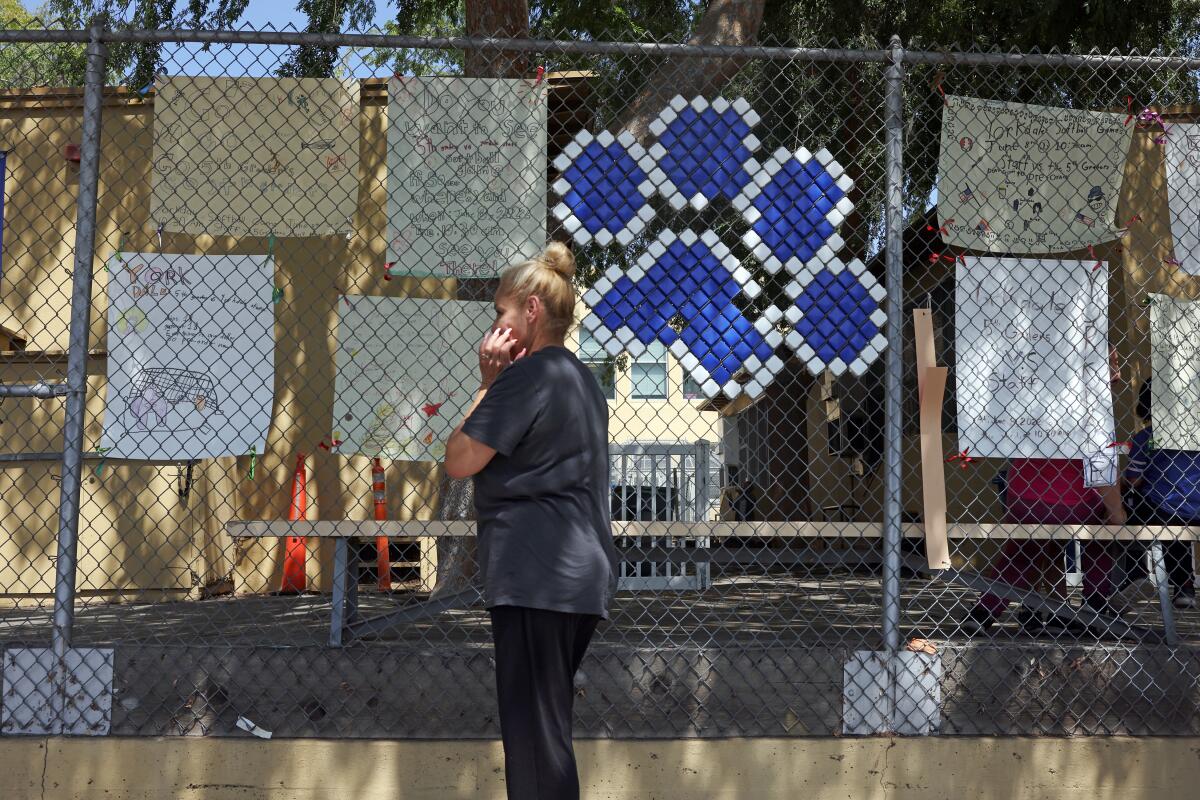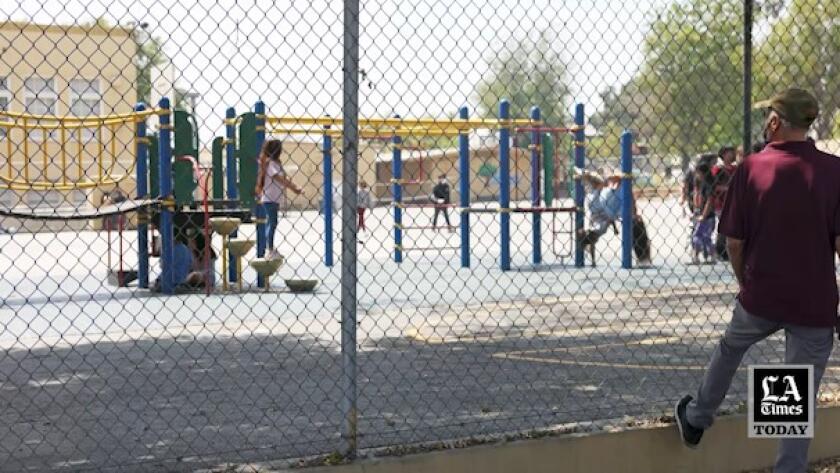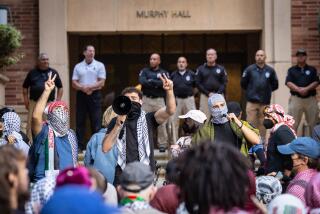The limits to school security become clear as parents demand answers after Texas shooting

The Texas school shooting has prompted questions among Los Angeles-area parents about school security measures that could prevent similar violence on their children’s campuses. School officials tried to be reassuring — explaining how they work to keep children safe. But they could not make ironclad pledges.
“Moments like these force us as educators to reevaluate our safety measures,” said Gudiel Crosthwaite, superintendent of the Lynwood Unified School District. “As more information becomes available, we will collaborate with local authorities to reevaluate our safety measures and protocols and make the necessary adjustments. Kids and staff should not worry about their personal safety at school.”
He added: “After these type of incidents, anxiety increases and everyone wants a police officer at a school, but that alone will not solve nor stop these incidents. Our country has a long-troubled history with guns in schools and we have to raise our kids differently and hold elected officials and gun companies accountable because they too are responsible for the loss of life.”
Here is more of what school officials and experts have to say.
Watch L.A. Times Today at 7 p.m. on Spectrum News 1 on Channel 1 or live stream on the Spectrum News App. Palos Verdes Peninsula and Orange County viewers can watch on Cox Systems on channel 99.
What works best to keep schools safe?
There is broad agreement that prevention is the best tool. This can take the form of “see something, say something” campaigns, enhanced counseling and anti-bullying efforts.
School officials often point to steps that could be taken outside of education, including gun-control laws and background checks for gun purchases. Solutions preferred from the political right include arming teachers.
Law enforcement is typically the last line of defense. Investigators often track social media.
Having officers on campus has sparked much debate. Researchers cite examples where officers have contributed to a negative school climate. But other experts say that well-trained officers — who nurture positive relationships and support counseling efforts — can have a positive impact.
How safe are schools?
Schools are likely safer than many places that people gather including stores, markets, street fairs and outdoor public events. At schools, staff members pay close attention to strangers and stay alert for people who don’t belong on campus. There’s also attentiveness to employees and students who appear to be struggling with mental-health issues.
In addition, campuses are generally locked-up places — especially in Southern California. At many campuses doors are locked for most of the school day.
Officials repeatedly assert that schools are safer than the surrounding community.
Campuses also are supposed to be safe havens from bullying and threats on the inside. Much progress has been made in recognizing the seriousness of bullying and taking action to prevent it, said Professor Ron Avi Astor, an expert in school violence at UCLA’s Luskin School of Public Affairs. He noted that it’s difficult to measure how much violence has been prevented, both in terms of bullying and its repercussions.
Do schools have campus police officers to protect them?
The general answer is no.
The nation’s second-largest school system, Los Angeles Unified, has had the second-largest police force in the country, but it was always spread thin on a school-by-school basis. Typically, one officer was assigned to a high school and an officer would be split between two middle schools. Elementary schools had roving patrols.
Under recent policy changes, the school system has removed officers from campus and reduced the size of the force, extending the range for the remaining patrol officers.
Why did L.A. Unified and other districts cut or eliminate school police?
The L.A. school board took this step in response to student and community activists who said the presence of police on campus criminalized students, especially Black and Latino students. Activists stepped up their calls to eliminate school police in the wake of the killing of George Floyd by a Minneapolis police officer two years ago.
A board majority voted to reduce school police funding by 35% and instead directed more funding to campus climate counselors and Black student achievement initiatives. The action was taken without an evaluation of ongoing security needs. Activists continue to pursue the full elimination of the department.
The Oakland Unified school board took the full step of voting to eliminate its small police department by gradually phasing out its operations. In assembling a database, Education Week found that at least 33 districts had eliminated school resource officers, out of about 17,000 school districts nationwide.
Most school systems do not have a police force at all. But many contract with the local city or sheriff for services and a police presence on campus. And some city police departments assign officers with a special focus on schools. Many schools also rely on unarmed security aides.
How have school leaders responded in the wake of the shooting?
L.A. schools Supt. Alberto Carvalho said his district has been a leader in safety measures and that district schools are notably safe. But he nonetheless convened a cabinet meeting in the wake of the Texas shooting.
Officials discussed how to make school perimeters more secure and further limiting the number of entrances at the open and close of the school day. Carvalho also wants to ensure that students and teachers know which areas of a campus are safest in an active-shooter situation, a strategy called “safe corners.” The district also is reconnecting with first responders, including police, fire and medical personnel, so that updated communication plans are in place and they have maps of campuses.
In addition, the district is looking into adding more security cameras and training students in peer-to-peer interactions, so they can reach out to classmates and report concerns.
“Notwithstanding these terrible massacres, despite those egregious violations of the safety of the school, schools are still the safest places for children in America,” Carvalho said.
What were school officials already doing to keep schools safe?
In Las Virgenes Unified, which straddles the Ventura County border, Supt. Dan Stepenosky responded Wednesday to inquiries about security from parents.
“In the past two years alone, we have spent more than $1.5 million in school safety enhancements and upgrades,” he wrote to parents. “Specifically, we have installed an additional 200 cameras — increasing our total number to more than 400 cameras districtwide; expanded our fencing and gates while reducing access points; completed an exhaustive school safety review by the National School Safety Center, and expanded our comprehensive approach to mental health services.”
Other measures, he added, are under consideration.
District leaders across the region have reminded parents of measures already in place. A message sent out Tuesday by Glendale Unified Supt. Vivian Ekchian emphasized the district’s multi-level approach.
First, Ekchian listed counseling guides available to parents and teachers, such as “Talking to Children About Violence: Tips for Parents and Teachers,” from the National Assn. of School Psychologists. She also outlined mental-health supports available through the school system.
Also, Ekchian said: If you see something, say something. The district has a tip line and also an app to report concerns.
Glendale schools have emergency plans in place for natural disasters, bomb threats and active shooters. Like most schools in Southern California, Glendale schools have security gates and cameras — and visitors must sign in and out. Families are encouraged to keep emergency contact information up to date.
There are limits to what school systems can do about guns off campus and in homes. Glendale and L.A. Unified are among the districts that remind parents of their legal responsibilities to safely store firearms.
How do I get information about security incidents at schools?
This is a persistent problem. Schools and districts have typically treated crime issues as confidential matters. Historically, L.A. Unified, for example, has made it almost impossible to obtain crime-related data for individual campuses, for incidents including fights, graffiti, other vandalism, vaping in bathrooms and thefts.
It’s harder to keep a more significant crime private when municipal police become involved.
More to Read
Sign up for Essential California
The most important California stories and recommendations in your inbox every morning.
You may occasionally receive promotional content from the Los Angeles Times.












